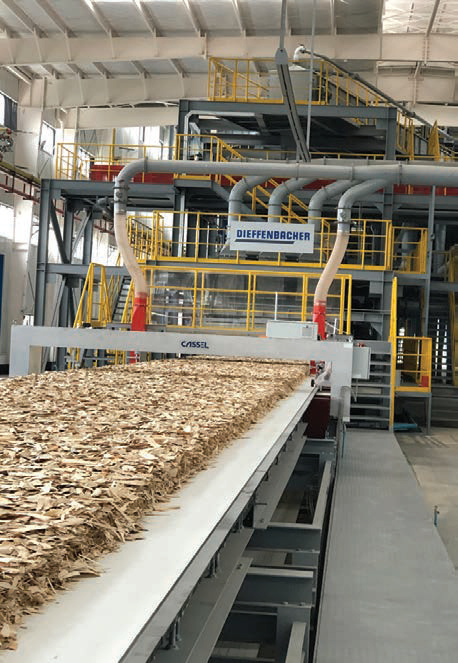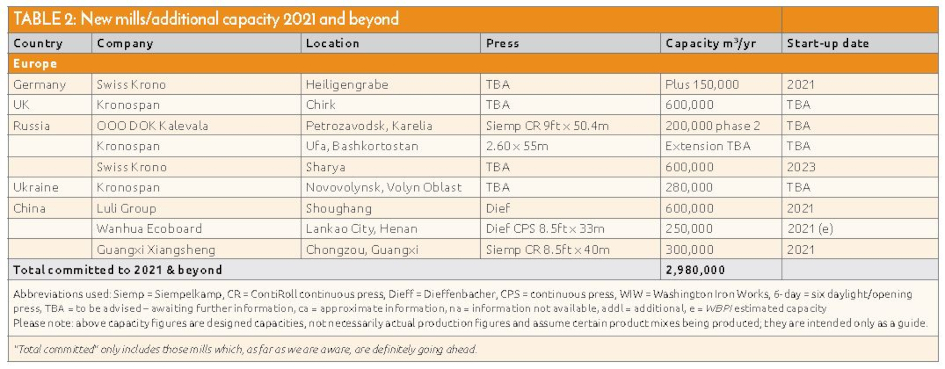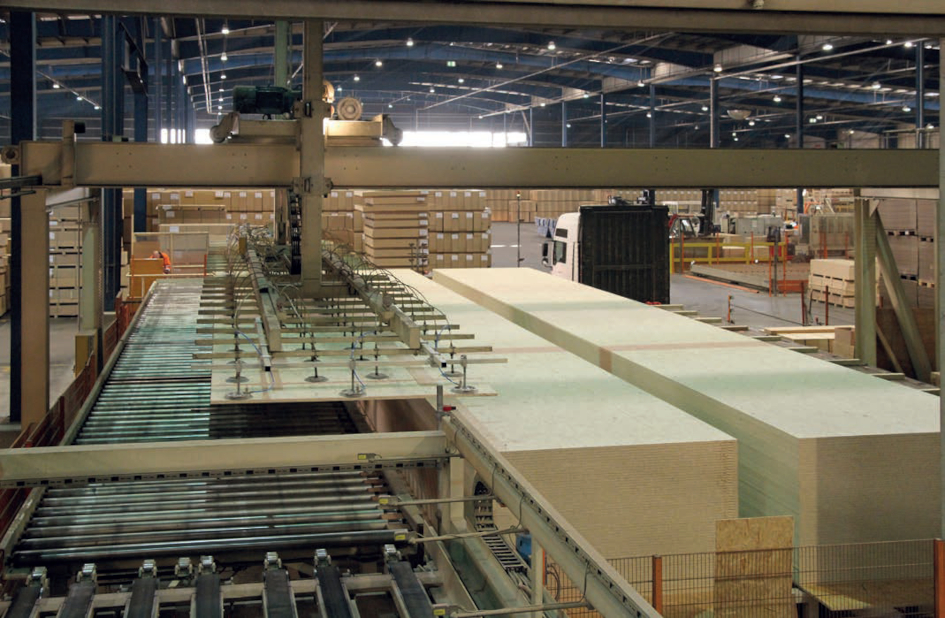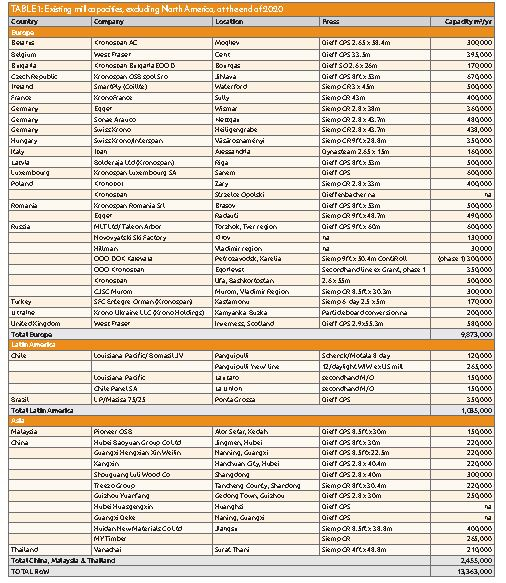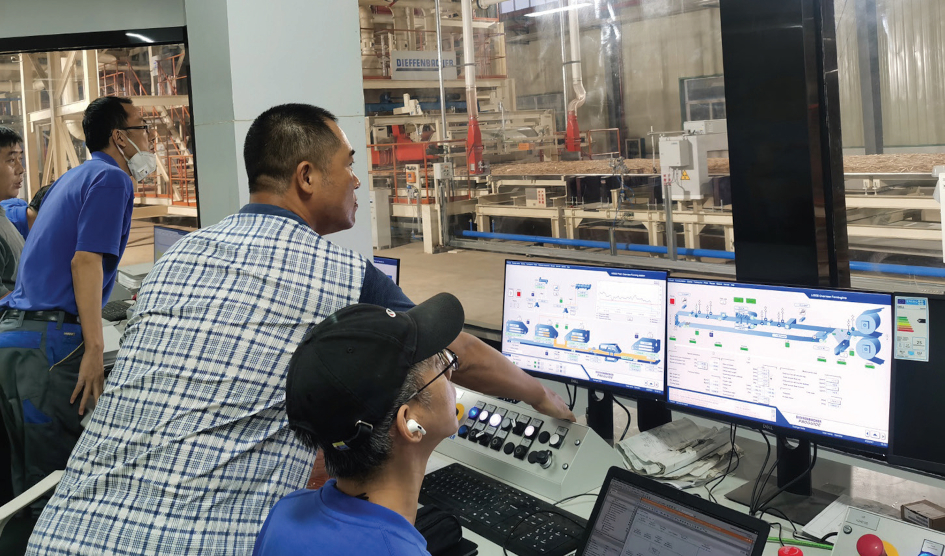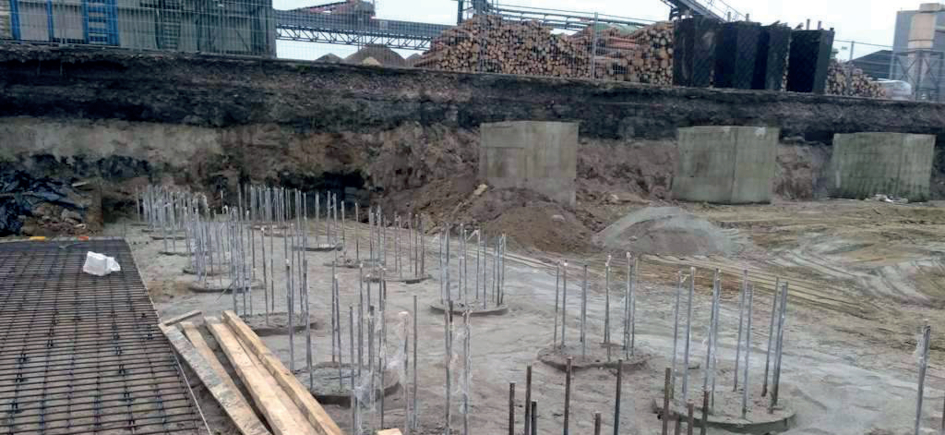Russia and China lead the way
28 May 2021Despite the pandemic, demand for OSB (including OSB hybrid products) and rising product prices are supporting further investment in global OSB capacity, with Russia and China leading the way. Stephen Powney reports
What a difference a year makes. This time last year as WBPI was filing the annual Focus on OSB report, the Covid-19 pandemic was starting to spread globally and doom and gloom were the order of the day.
Fast forward to 2021 and prices, production rates and markets for wood-based panels are looking healthy, with producers also more confident to invest in their facilities.
As stated in our North America focus on OSB report, OSB price increases seen in the US during 2020 were extraordinary and although price movements experienced in Europe and other world regions were not as extreme, the outlook on price and market demand looks decidedly optimistic.
The focus of this report is the Rest of the World, majoring on Europe, Asia and South America.
At the end of 2020, we estimate global OSB production capacity was around 36 million m3, that’s growth of about 2 million m3 over 2019. European capacity (including Russia) is marginally higher at nearly 10 million m3; North American capacity is estimated at 22.5 million m3 but it is China and Asia generally that is seeing the biggest investment in new capacity with regional growth of more than 1 million m3 in 2020 to a total estimated 2.5 million m3. Our estimation for total Rest of the World (excluding North America) is 13.4 million m3.
Two major and continuing trends we are seeing is eastern European investment in OSB and an increasing focus in Asia on OSB hybrid boards.
Russia is an important focus for OSB investment although some previously mentioned planned projects in our WBPI surveys have failed to materialise due to funding and other difficulties and without any concrete update on when or if they may resurface, we have decided to remove some of these projects from our list of future capacity, though will reinstate any that move forward in the future. The United Nations Economic Commission for Europe's (UNECE) most recent statistics show a projected European OSB production output (excluding the CIS) of 7,519,000m3 in 2020, a 1.23% increase on the 7,427,000m3 UNECE recorded in 2019. The separate 2020 production forecast for OSB producers in the CIS (Russia, Ukraine, Belarus) is 2,467,000m3 and the figure for 2019 is 2,278,000m3.
The European Panel Federation (EPF) did not forecast in its annual report 2019-2020 published last year due to uncertainty related to the effects of Covid-19. Its most recent stats for the European OSB sector show OSB production in the EU-28. The 2019 production total is 6,771,000m3 for this region, a 0.8% reverse on the 6,828,000m3 recorded in 2018, which EPF says was the result of force majeure at some plants and slowing growth in construction.
The EPF shows apparent OSB consumption in the EU-28 was up 2.2% to 5.881 million m3 in 2019, while imports rose slightly and exports declined by 3.3%.
WESTERN EUROPE
Western Europe has not been a big focus of large new OSB capacity investments of late, although there has been efficiency and improvement investment activity at specific existing mills.
One large new project which has been on the drawing board for several years now is Kronospan’s plan to build an OSB mill at its Chirk facility in the UK with an expected annual capacity of 600,000m3.
It was granted planning permission in early 2019 after delays and still needs an environmental permit.
Natural Resources Wales (NRW), the organisation which decides on such permits, issued an update in March, 2021 about the situation and permits for the Chirk site generally.
It is currently in the process of consolidating the two regulator’s permits and conducting a full review of the conditions to ensure compliance with EPR, the Industrial Emissions Directive (IED) and BAT.
NRW said Kronospan’s application also originally contained a proposal for the new OSB production line which will now be considered “at a later date”.
“Several issues remain unresolved in relation to Kronospan’s application for a new OSB production line, the most significant being the noise assessment,” NRW said. “NRW consider that the background data is currently not representative, so we cannot determine the magnitude of the predicted noise impact associated with the proposed OSB development.
“Kronospan Ltd have been unable to collect representative data during 2020; due to adverse weather conditions in February and early March, 2020, following which the Covid-19 restrictions then commenced. Any survey conducted during this time would be considered unrepresentative of normal site conditions.”
So, NRW cannot give a definitive date for a draft decision on the OSB application.
“However, if we decide to grant the OSB application, we will consult with the public on our draft decision once we have reached this stage,” it added.
We have now added the Kronospan OSB project to Table 2 – new mills/additional capacity – with start-up date to be advised.
Staying with the UK, Norbord (which has now become part of West Fraser) stated in its annual financial results published in February that its European panel mills produced at 87% of stated capacity in 2020 versus 88% in 2019.
The decrease in capacity utilisation was driven by the 225 million ft2 (22,000m3) restatement of capacity from the completion of Phase 2 of the Inverness OSB mill expansion project.
The output was still enough to achieve annual production records at Inverness and Genk. The company’s results show a good outcome for 2020 despite its announcements earlier in the year (during the onset of the pandemic) about adjusting mill operating schedules as needed to match production with demand.
Norbord’s European operation results, which includes the OSB facilities at Inverness and Genk, showed adjusted EBITDA of US$48m in 2020 (2019: US$64m).
Encouragingly, Q4, 2020, showed an upward trend with adjusted EBITDA of US$20m (2019 Q4: US$11m).
“In Europe, our results were more adversely impacted [compared to North American operations] by the pandemic though we saw steady improvement in the back half of the year with panel prices recovering and production ramping up at the recently commissioned Inverness, Scotland Phase 2 expansion,” said the company.
The Norbord Genk OSB facility will also be improved with a new drying system from Büttner of type 6,5 x 33 R, 4 new cyclones with ceramic tiling and complete new ducting.
The installation work will commence at the end of 2021.
At the SmartPly OSB mill at Waterford in Ireland, a €44.4m investment was approved last year to improve and upgrade the drying plant to improve resource efficiency and asset reliability while greatly increasing plant capacity.
The announcement comes as the company looks to scale up production levels to meet the continual strong demand for its products. It is unclear how much the output will change beyond the plant’s current stated 500,000m3 capacity.
Italian company PAL will be involved in this project – for the new complete OSB dry screening system for a capacity of 35 t/h. The system will be engineered in accordance to the latest ATEX standards and the installation is due to take place in Q2, 2021.
Elsewhere in Europe, Germany and Romania continue to have the largest OSB output, followed by Poland.
According to UNECE stats, Romania was the number one OSB producer with an output of 1,369,000m3 in 2019, with Germany second at 1,163,000m3, representing the second year of decline for the latter. But the most recent German federal statistics to come out, cited by Germany-based industry newsletter EUWID, show a 6.1% growth in Germany’s OSB production output in 2020 to 1,234,000m³, with prices continuing to rise.
Swiss Krono’s planned increased capacity at Heiligengrabe, which is partly to produce more OSB4 boards, is scheduled to be realised in 2021/22. The existing 438,000m3 capacity plant is planned to be increased to reach near 600,000m3.
EASTERN EUROPE
Eastern Europe continues to offer OSB investment potential, with Russia and Ukraine being the main focus.
Russia’s OSB capacity has been a story of big growth in a short period of time, with its production output rising in 2019 to 1,455,000m3 (estimated by UNECE), up 7.3% on 2018.
Construction sector demand for OSB and rising OSB prices have fuelled capacity growth in the product.
Many projects have been planned in recent years, but not all are coming to fruition, either due to funding or other issues.
Projects we are highlighting at this time are CJSC Murom, Swiss Krono at Sharya and Kronospan, Ufa.
Plywood and chipboard producer CJSC Murom, based in Murom in Vladimir region, placed an order with Siempelkamp back in 2018 for an 8.5ft x 30.3m ContiRoll press with a capacity of approximately 300,000m3. We have been informed that all equipment was supplied and the first board was produced in November, 2020, with the fine-tuning process currently ongoing.
This project has now been added to Table 1.
It will make OSB Advanced, fully utilising round timber resources used in plywood production for its wood-based material production, saving considerable production costs. With OSB Advanced, CJSC Murom will be able to offer a formaldehyde-free OSB board.
Swiss Krono’s Sharya project in Kostrama region involves a 600,000m3 OSB plant featuring a Dieffenbacher 65m-long press which will be one of the largest of its kind in Russia.
The project is part of a €340m investment programme in the company’s Russia operations. Swiss Krono Group’s investment projects were interrupted a year ago during the onset of the Covid-19 pandemic but subsequently resumed and around €180m of investments were planned for the 2020/21 financial year in total. The largest of those projects is the launch of OSB production at Sharya, which we are told is now likely to be completed in 2023.
Kronospan Holdings East Ltd is considering investing about RUB18.4bn (US$250m) in the expansion of its production facilities in the Bashkiria Republic, as detailed by our Russia correspondent Eugene Gerden (see pages 26-28).
Ilshat Tazhitdinov, first deputy prime minister of the government of Bashkiria, confirmed the plans as projects for OSB and binding materials. Kronospan has an existing OSB plant in Ufa, opened only in 2018 with a 65m press (estimated 500,000m3 capacity) but the latest proposals apparently target a doubling of the company’s local OSB capacities to meet demand in the Volga region and foreign markets.
Data from regional authorities show 876,000m3 of OSB was produced at Ufa between 2018-2020.
Projects we have removed from Table 2 (future capacity increases) until further updates are received include: Ugra-Plit, Sovetsky. We understand the project is suspended while Khanty-Mansiysk autonomous district authorities continue a search for investors in the company.
Also removed are Stroymontazh Technologiya, SibayPlitProm (Bashkortostan) and Chinese Sichuan Rly & Real Invest (Volga region). A further project planned by unknown investors in the Vologda region has also been suspended due to a change of owners of the main investor.
And we have also removed the entry for ORIS LLC, as the equipment it purchased was re-sold and ultimately ended up in Kronospan’s Ufa plant.
Another project is existing OSB producer OOO DOK Kaevala’s phase two 200,000m3 extension plans at Petrozavodsk, Karelia. We understand the second stage was suspended in June 2020 although could be resumed as equipment is already purchased.
Meanwhile, in Ukraine, Kronospan has plans to open up an OSB plant at Novovolynsk, Volyn in a €166m investment.
Natalia Pokinska, general director of Kronospan Ukraine, made comments about the projects during a meeting last year with the Ukrainian president Volodymyr Zelensky.
“The commissioning of OSB production in Novovolynsk allows us to start exports of those products, which were previously imported to Ukraine,” said Ms Pokinska.
At present Kronospan already operates a particleboard plant in Ukraine, which was commissioned in 2004 in Novovolynsk, 40km from the Polish border.
The company’s planned OSB plant will have an annual capacity of 280,000m3, with production aimed at the domestic market.
The installation (start-up date to be advised) will be equipped with a directly heated dryer and a multi-daylight press.
Currently, there is one existing OSB plant in Ukraine operated since 2012 by Swiss Krono Group.
In Poland it is worth noting that the Strzelce Opolskie mill has been out of action since a fire last October, which will impact production output in the region. The mill was expected to be back on line around the time of publication of this issue of WBPI.
ASIA
China’s production of OSB has been increasing at a good rate over the past five years and new projects recently coming on line have taken Chinese OSB capacity to around the 2 million m3 mark, with the majority of production going into furniture applications.
Complete panel line equipment supplier Dieffenbacher has provided numerous OSB lines to China in recent years and has worked with panel producers worldwide to develop OSB variants such as the co-called “Fine OSB”, which typically involves a core OSB layer with particleboard surfaces.
Fine OSB combines the robustness of OSB with the surface quality of particleboard, making further processing possible according to individual needs, such as laminating or coating. The lower cost of raw material also provides an alternative to plywood.
Since appearing around five years ago, Fine OSB has become increasingly popular.
Dieffenbacher saw two of its Fine OSB projects produce their first boards during 2020, despite the pandemic. These are Hubei Huashengxin in Huangshi (October, 2020) and Guangxi Deke in Nanning (September, 2020).
A further Fine OSB line is currently under construction for Luli Group at Shoughang with a capacity of 600,000m3, with an expected first board this summer.
In addition, Dieffenbacher is continuing to partner with Wanhua Ecoboard, with a fine OSB production line planned in Lankao, Henan Province with a projected capacity of 250,000m3 and CPS+ in dimensions of 8.5ft x 33m.
Meanwhile, Siempelkamp also had two projects completed in 2020: Jiangsu Huidian, system with ContiRoll for OSB/ PB. Production output per day is 1,240m³ (400,000m3 estimated annually). The press is 8.5ft x 38.8m.
The second is MY Timber, featuring a ContiRoll system for OSB/particleboard, with production output per day being 800m³ (265,000m3 estimated annually).
A further Siempelkamp project for hybrid OSB/particleboard production is Guangxi Xiangsheng, China, system with ContiRoll for OSB/PB, with an annual production capacity of 300,000m3. This is expected to be completed in 2021.
The plant includes a ContiRoll Generation 9 press measuring 8.5ft x 40m, equipped with five forming head and Siempelkamp’s Universal Flaker.
It offers production capability of OSB, light OSB, fine surface OSB and load-bearing special purpose board.
Elsewhere in Asia, Vanachai’s OSB project at Surat Thani started production in 2020 and has also been added to the main listing. Using rubberwood as the raw material, the plant features a Siempelkamp ContiRoll press 4ft x 48.7m, which is the longest 4ft ContiRoll from Siempelkamp and has an annual production capacity of 210,000m3.
IMAL-PAL Group also supplied significant equipment for the project. The production complements the wood-based panels offering in South-east Asia, which is dominated by particleboard and MDF.
